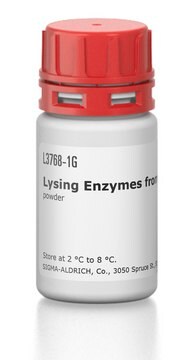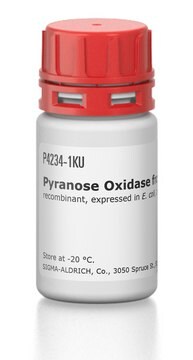HTS142M
ChemiScreen Membrane Preparation
Recombinant Human EP4 Prostanoid Receptor
Human EP4 GPCR membrane preparation for Radioligand binding Assays & GTPγS binding.
Autenticatiper visualizzare i prezzi riservati alla tua organizzazione & contrattuali
About This Item
Codice UNSPSC:
41106514
eCl@ss:
32161000
NACRES:
NA.41
Prodotti consigliati
Origine biologica
human
Livello qualitativo
Ricombinante
expressed in Chem-1 cells
Produttore/marchio commerciale
ChemiScreen
Chemicon®
tecniche
ligand binding assay: suitable (GTPγS)
radioligand binding assay (RLBA): suitable
N° accesso NCBI
N° accesso UniProt
Condizioni di spedizione
dry ice
Informazioni sul gene
human ... PTGER2(5734) , PTGER4(5734)
Descrizione generale
Human EP4
Prostanoids are a series of arachidonic acid metabolites produced by the action of cyclooxygenase and further modified by isomerases and syntheses. Cells rapidly secrete prostanoids after synthesis, whereupon the prostanoids bind to a family of 8 GPCRs to exert their biological effects (Narumiya and FitzGerald, 2001). The prostaglandin PGE2 causes pain, vasodilation, immunosuppression of T cells, bone remodeling and promotion of carcinogenesis. Four related GPCRs, EP1, EP2, EP3 and EP4, each bind to PGE2, but the different G protein coupling status of each receptor leads to distinct biological effects. EP4 couples primarily to Gs to increase intracellular cAMP levels. During neonatal development, EP4 participates in closure of the ductus arteriosus, a process required for switching circulation from the placenta to the lungs (Nguyen et al., 1997). In addition, EP4 mediates PGE2-induced bone formation by promoting osteoblastogenesis, and selective EP4 agonists are being evaluated as potential treatments for osteoporosis (Yoshida et al., 2002). Chemicon′s EP4 membrane preparations are crude membrane preparations made from our proprietary stable recombinant cell lines to ensure high-level of GPCR surface expression; thus, they are ideal HTS tools for screening of antagonists of EP4 interactions with prostaglandin E2. The membrane preparations exhibit a Kd of 1.27-1.85 nM for [3H]-Prostaglandin E2. With 5 µg/well EP4 Membrane Prep and 1.5 nM [3H]-Prostaglandin E2, a greater than 3-fold signal-to-background ratio was obtained.
Applicazioni
Radioligand binding assay, and GTPγS binding.
Azioni biochim/fisiol
GPCR Class: A
Protein Target: EP4
Target Sub-Family: Prostanoid
Qualità
SPECIFICATIONS:
Signal:background and specific binding values obtained in a competition binding assay with varying amounts of EP4 membrane prep:
1 unit = 10 µg membrane preparation
Bmax: 16.1 pmol/mg
Kd: 1.57 nM
Signal:background and specific binding values obtained in a competition binding assay with varying amounts of EP4 membrane prep:
| 10 µg/well | |
|---|---|
| Signal:Background | 3.9 |
| Specific Binding (cpm) | 643 |
1 unit = 10 µg membrane preparation
Bmax: 16.1 pmol/mg
Kd: 1.57 nM
Specifiche
Inucbation Conditions
Membranes are mixed with radioactive ligand and unlabeled competitor (see Figures 1 and 2 for concentrations tested) in binding buffer in a nonbinding 96-well plate, and incubated for 1-2 h. Prior to filtration, a GF/C 96-well filter plate is coated with 0.33% polyethyleneimine for 30 min, then washed with 50mM HEPES, pH 7.4, 0.5% BSA. Binding reaction is transferred to the filter plate, and washed 3 times (1 mL per well per wash) with Wash Buffer. The plate is dried and counted.
Binding buffer: 50 mM Hepes, pH 7.4, 5 mM MgCl2, 1 mM CaCl2, 0.2% BSA, filtered and stored at 4°C
Radioligand: [3H] prostaglandin E2 (Perkin Elmer # NET428)
Wash Buffer: 50 mM Hepes, pH 7.4, 500mM NaCl , 0.1% BSA, filtered and stored at 4°C.
Membranes are mixed with radioactive ligand and unlabeled competitor (see Figures 1 and 2 for concentrations tested) in binding buffer in a nonbinding 96-well plate, and incubated for 1-2 h. Prior to filtration, a GF/C 96-well filter plate is coated with 0.33% polyethyleneimine for 30 min, then washed with 50mM HEPES, pH 7.4, 0.5% BSA. Binding reaction is transferred to the filter plate, and washed 3 times (1 mL per well per wash) with Wash Buffer. The plate is dried and counted.
Binding buffer: 50 mM Hepes, pH 7.4, 5 mM MgCl2, 1 mM CaCl2, 0.2% BSA, filtered and stored at 4°C
Radioligand: [3H] prostaglandin E2 (Perkin Elmer # NET428)
Wash Buffer: 50 mM Hepes, pH 7.4, 500mM NaCl , 0.1% BSA, filtered and stored at 4°C.
Stato fisico
One package contains enough membranes for at least 200 assays (units), where an unit is the amount of membrane that will yield greater than 3-fold signal:background with 3H-labeled prostaglandin E2 at 1.5 nM.
Liquid in packaging buffer: 50 mM Tris pH 7.4, 10% glycerol and 1% BSA with no preservatives.
Packaging method: Membranes protein were adjusted to the indicated concentration in packaging buffer, rapidly frozen, and stored at -80°C.
Liquid in packaging buffer: 50 mM Tris pH 7.4, 10% glycerol and 1% BSA with no preservatives.
Packaging method: Membranes protein were adjusted to the indicated concentration in packaging buffer, rapidly frozen, and stored at -80°C.
Stoccaggio e stabilità
Maintain frozen at -70°C for up to 2 years. Do not freeze and thaw.
Note legali
CHEMICON is a registered trademark of Merck KGaA, Darmstadt, Germany
Esclusione di responsabilità
Unless otherwise stated in our catalog or other company documentation accompanying the product(s), our products are intended for research use only and are not to be used for any other purpose, which includes but is not limited to, unauthorized commercial uses, in vitro diagnostic uses, ex vivo or in vivo therapeutic uses or any type of consumption or application to humans or animals.
Codice della classe di stoccaggio
12 - Non Combustible Liquids
Classe di pericolosità dell'acqua (WGK)
WGK 2
Punto d’infiammabilità (°F)
Not applicable
Punto d’infiammabilità (°C)
Not applicable
Certificati d'analisi (COA)
Cerca il Certificati d'analisi (COA) digitando il numero di lotto/batch corrispondente. I numeri di lotto o di batch sono stampati sull'etichetta dei prodotti dopo la parola ‘Lotto’ o ‘Batch’.
Possiedi già questo prodotto?
I documenti relativi ai prodotti acquistati recentemente sono disponibili nell’Archivio dei documenti.
M Nguyen et al.
Nature, 390(6655), 78-81 (1997-11-18)
Survival of newborn placental mammals depends on closure of the ductus arteriosus (DA), an arterial connection in the fetus which directs blood away from the pulmonary circulation and towards the placenta where oxygenation occurs. Here we show that morphological changes
Stimulation of bone formation and prevention of bone loss by prostaglandin E EP4 receptor activation
Yoshida, Keiji, et al
Proceedings of the National Academy of Sciences of the USA, 99, 4580-4585 (2002)
Genetic and pharmacological analysis of prostanoid receptor function.
S Narumiya et al.
The Journal of clinical investigation, 108(1), 25-30 (2001-07-04)
Il team dei nostri ricercatori vanta grande esperienza in tutte le aree della ricerca quali Life Science, scienza dei materiali, sintesi chimica, cromatografia, discipline analitiche, ecc..
Contatta l'Assistenza Tecnica.







